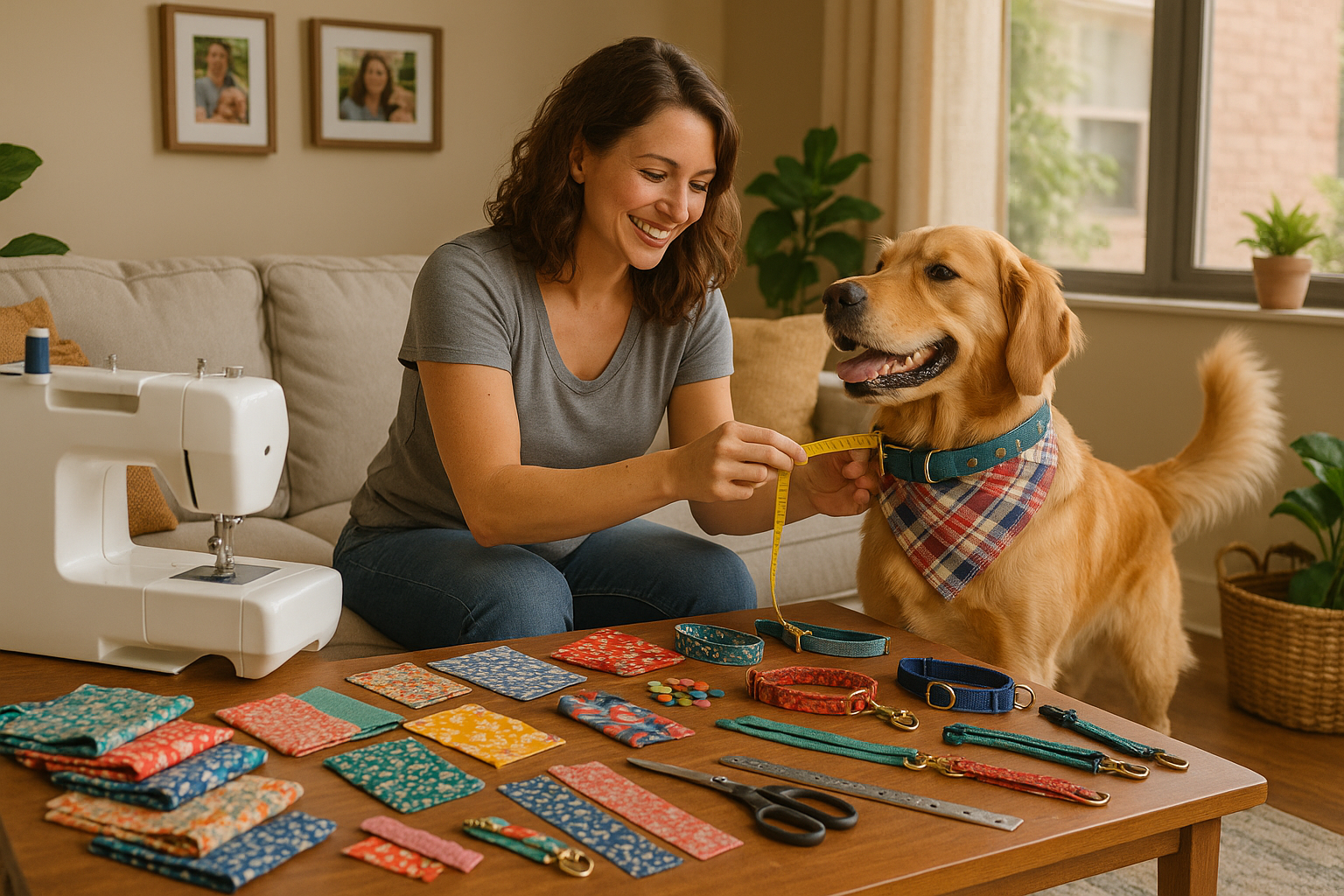🐶 The best part? You don’t need to be a seasoned DIY enthusiast or a dog behaviorist to pull this off. All you need is some passion, a bit of time, and this comprehensive guide to help you along the way.
Yes, the pet industry is thriving with an array of dog gear, toys, and accessories. But, nothing beats the satisfaction of creating something unique and personalized for your furry friend. Plus, it’s an opportunity to engage your creative side and save some money. Let’s not forget the sense of accomplishment that comes with seeing your dog wag its tail with joy at your creation. 🎉
Before we delve into the practicalities of making your own dog gear, it’s crucial to understand the why behind this project. First, creating your own dog gear allows you to tailor each piece to your dog’s specific needs, whether it’s comfort, functionality, durability, or all of these. Secondly, it’s an opportunity to incorporate sustainable materials and practices into your creations, making a small yet significant contribution to environmental conservation. Lastly, it’s a fun and engaging project that strengthens the bond between you and your furry friend.
This post serves as a comprehensive guide to creating your own stylish and functional dog gear at home. It’ll cover all the essentials, including the necessary tools and materials, step-by-step instructions for a variety of DIY dog gear, and tips for making each item as comfortable and durable as possible.
What to Expect in This Guide
So, what exactly will we cover in this guide? Well, we’ll begin by outlining the essential tools and materials you’ll need to start your DIY project. You might be surprised to learn that many of these items are already lying around your house, waiting to be repurposed. ✂️📏
Next, we’ll delve into several step-by-step guides for creating different types of dog gear. We’ll start with something simple, like a homemade dog toy, before moving on to more complex projects like dog beds, dog leashes, and even dog clothes. We’ll provide clear, concise instructions for each project, ensuring you can follow along, regardless of your DIY skill level.
Apart from the DIY steps, we’ll also provide tips on choosing the right materials based on your dog’s size, breed, and preferences. Additionally, we’ll offer advice on ensuring the safety and comfort of your dog when using the homemade gear.
In the final section of this guide, we’ll touch on how to care for and maintain your DIY dog gear. After all, a little upkeep goes a long way in extending the lifespan of your creations. Plus, it ensures that your dog can enjoy its new gear for a long time to come.
Whether you’re a DIY newbie or a seasoned creator, this guide will provide you with everything you need to create stylish and functional dog gear at home. So, roll up your sleeves and get ready to unleash your creativity. Your four-legged friend will thank you for it! 🐾
Let’s dive in and get those tails wagging! 🎈
Unleash Your Creativity: Crafting Personalized Dog Gear at Home
Are you a proud pet parent looking to dabble in DIY for your beloved canine? Or perhaps an experienced DIYer looking for your next project? Well, you’re in the right place! This article will guide you through creating stylish, functional, and custom gear for your four-legged friend. Remember, every good DIY project starts with a great plan! So let’s dive right in.
Before we begin, let’s clarify something: You don’t need to be a master craftsman or an expert seamstress to create bespoke gear for your dog. All you need is a dash of creativity, a pinch of patience, and a whole lot of love for your furry friend. From crafting unique dog collars to designing comfortable dog beds, there’s no end to what you can create. It’s not just about saving money, but also about creating something unique that reflects your dog’s personality.
Creating dog gear at home isn’t just a fun and fulfilling project. It also ensures that the gear fits your dog perfectly, is made from materials that won’t harm them, and can be easily replaced if it gets damaged or worn out. So, let’s roll up our sleeves and get started! Remember to watch this helpful YouTube video for DIY Dog Gear ideas by “DIY Crafts TV” before you start: DIY Dog Gear Ideas – DIY Crafts TV
Step 1: Designing the Perfect DIY Dog Collar
One of the simplest yet most impactful ways you can start your DIY dog gear project is by creating a custom dog collar. Not only is it a fun and creative project, but a DIY collar also allows you to control the quality and fit, ensuring your dog’s comfort and safety. Before you start, make sure you have a good understanding of your dog’s neck size and the type of collar that suits them best. Take a look at the table below for a general guide:
| Dog Size | Collar Type | Neck Size Range |
|---|---|---|
| Small | Flat Collar | 10-14 inches |
| Medium | Martingale Collar | 14-20 inches |
| Large | Prong Collar | 18-26 inches |
Once you have these details sorted, it’s time to let your creativity shine! Choose the material you want to use for the collar. You can opt for durable fabrics like nylon or leather for an elegant look. Don’t forget to pick out a stylish buckle and consider adding a personalized name tag or charm for that special touch.
Step 2: Crafting a Comfortable and Stylish Dog Bed
After a long day of walks, play, and wagging their tails, every dog deserves a cozy place to rest. So why not create a stylish and comfortable bed that your dog will love? To start with, you’ll need to measure your dog while they’re sleeping to get a good idea of the size of the bed. Make sure to add a few extra inches on all sides for a comfortable fit.
Next, choose a durable and washable fabric for the cover. Consider getting a fabric with a pattern or color that matches your home decor. For the stuffing, you can use foam, old clothes, or even old pillows. Remember to make the bed thick enough to be comfortable, but not so high that it’s difficult for your dog to get on and off.
Creating a DIY dog bed can be a simple or complex project, depending on your sewing skills and the design you choose. You can make it as simple as sewing two large pieces of fabric together and stuffing them, or as complicated as creating a raised bed with wooden legs. Here’s a handy YouTube video for creating a DIY dog bed: DIY Dog Bed – BuzzFeed Nifty.
Step 3: Creating Fun and Safe DIY Dog Toys
One of the best ways to keep your dog entertained and active is by providing them with a variety of toys. However, buying new toys regularly can quickly become expensive. So, why not make your own? DIY dog toys are an easy, fun, and cost-effective way to keep your pup entertained.
From tug toys made from old t-shirts to interactive treat-dispensing toys, there are plenty of ideas you can try. Just make sure that any toy you create is safe for your dog. Avoid using small parts that can be swallowed, and always supervise your dog while they’re playing with the toy.
Creating DIY dog toys can also be a fun way to upcycle old items around your house. Old socks, water bottles, and even cardboard can be transformed into exciting toys for your pet. Remember to check out this YouTube video for DIY Dog Toy ideas: DIY Dog Toy Ideas – Dog’s Trust.
Final Thoughts
Creating DIY dog gear can be a rewarding experience, both for you and your dog. Not only will you end up with unique and personalized gear, but you’ll also have the satisfaction of knowing you created it yourself. Plus, DIY projects can be a great way to spend time with your pet and strengthen your bond.
So, whether you’re a seasoned DIYer or a novice looking to try something new, why not give these projects a try? With a bit of creativity and some basic supplies, you can create stylish and functional gear that your dog will love. And who knows? You might just discover a new hobby in the process!

Conclusion
In conclusion, the realm of information technology and engineering is a rapidly evolving field, presenting a myriad of opportunities and challenges. The insights provided in this article have sought to elucidate the various intricacies of these sectors, with a particular focus on the role of software engineering and its applicability in the contemporary digital world.
From the onset, we examined the fundamentals of software engineering, delving into its essential principles, methodologies, and practices. We explored the processes involved, such as requirements analysis, design, coding, testing, and maintenance, each contributing to the development of reliable, efficient, and robust software systems.
We also looked at the significance of quality assurance in software engineering, emphasizing its role in ensuring the creation of high-quality products that meet the needs and expectations of the end-users. Through various testing methods, developers can identify and rectify issues in the software, leading to improved user experiences.
Moreover, the article highlighted the relevance of cybersecurity in the IT sector, acknowledging the increasing prevalence of cyber threats in today’s digital landscape. By implementing robust security measures and strategies, organizations can protect their data and systems from potential attacks, thus maintaining their integrity and credibility in the business environment.
We also touched on the impact of emerging technologies like Artificial Intelligence and Machine Learning, IoT, Big Data, and Blockchain, underscoring how these innovations are revolutionizing the IT and engineering fields. These technologies offer transformative potentials, with numerous applications in various sectors, ranging from healthcare and education to finance and transportation.
Despite the complexity of these subjects, this article has strived to present the information in a digestible and understandable manner. The primary objective has been to demystify the technical jargon and present the concepts in a way that even individuals with minimal technical knowledge can comprehend.
If you found this information useful, feel free to share the knowledge with your peers, comment with your thoughts and experiences, or even apply these insights in your professional endeavours. Remember, knowledge is power, and sharing it contributes to the growth and development of our digital society. 😊
For further reading, you can check out these resources: Source Link 1, Source Link 2. Let’s continue the conversation and further our understanding of these fascinating fields.
Finally, remember that the future of IT and engineering lies in our hands. As we continue to navigate through the digital revolution, let’s strive to make the most of the opportunities presented, while also addressing the associated challenges. With determination, creativity, and collaboration, there’s no limit to what we can achieve. Let’s continue to innovate, transform, and redefine the future. 💪👩💻🌐
Remember: “Technology is nothing. What’s important is that you have a faith in people, that they’re basically good and smart, and if you give them tools, they’ll do wonderful things with them.” – Steve Jobs.
This post is tagged under: Tag 1, Tag 2, Tag 3.



